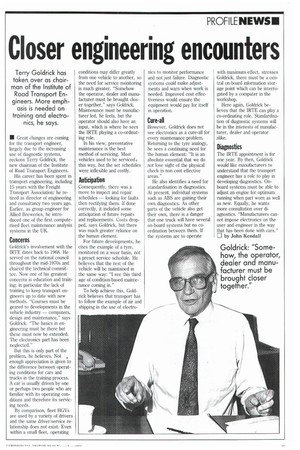Closer engineering encounters
Page 25

If you've noticed an error in this article please click here to report it so we can fix it.
Terry Goldrick has taken over as chairman of the Institute of Road Transport Engineers. More emphasis is needed on training and electronics, he says.
• Great changes are coming for the transport engineer, largely due to the increasing use of diagnostic systems, reckons Terry Goldrick, the new chairman of the Institute of Road Transport Engineers.
His career has been spent in transport engineering, including 15 years with the Freight Transport Association: he retired as director of engineering and consultancy two years ago. Earlier, as group engineer for Allied Breweries, he introduced one of the first computerised fleet maintenance analysis systems in the UK.
Concerns
Goldrick's involvement with the IRTE dates back to 1968. He served on the national council throughout the mid-1970s and chaired the technical committee. Now one of his greatest concerns is education and training: in particular the lack of training to keep transport engineers up to date with new methods. "Courses must be geared to developments in the vehicle industry — computers, design and maintenance," says Goldrick. "The basics in engineering must be there but these must now be extended. The electronics part has been neglected.'' But this is only part of the problem, he believes. Not enough appreciation is given to the difference between operating conditions for cars and trucks in the training process. A car is usually driven by one or perhaps two people who are familiar with its operating conditions and therefore its servicing needs.
By comparison, fleet HGVs are used by a variety of drivers and the same driver/service relationship does not exist. Even within a small fleet, operating conditions may differ greatly from one vehicle to another, so the need for service monitoring is much greater. "Somehow the operator, dealer and manufacturer must be brought closer together," says Goldrick. Maintenance must be manufacturer led, lie feels, but the operator should also have an input, which is where he sees the IRTE playing a co-ordinating role.
In his view, preventative maintenance is the best method of servicing. Most vehicles used to be serviced this way. but the set schedules were inflexible and costly.
Anticipation
Consequently, there was a move to inspect and repair schedules — looking for faults then rectifying them. If done correctly, it included some anticipation of future repairs and replacements. Costs dropped, says Goldrick, but there was much greater reliance on the human element.
For future developments, he cites the example of a tyre, monitored on a wear basis, not a preset service schedule. He believes that the rest of the vehicle will be maintained in the same way: "I see this third age of condition-based maintenance coming in."
To help achieve this, Goldrick believes that transport has to follow the example of air and shipping in the use of electro
nics to monitor performance and not just failure. Diagnostic systems could make adjustments and warn when work is needed. Improved cost effectiveness would ensure the equipment would pay for itself in operation.
Cure-all
However, Goldrick does not see electronics as a cure-all for every maintenance problem. Returning to the tyre analogy, he sees a continuing need for the human element: "It is an absolute essential that we do not lose sight of the physical check in non cost effective areas."
He also identifies a need for standardisation in diagnostics. At present, individual systems such as ABS are gaining their own diagnostics. As other parts of the vehicle also get their own, there is a danger that one truck will have several on-board systems but no coordination between them. If the systems are to operate
with maximum effect, stresses Goldrick, there must be a central on-board information storage point which can be interrogated by a computer in the workshop.
Here again, Goldrick believes that the IRTE can play a co-ordinating role. Standardisation of diagnostic systems will be in the interests of manufacturer, dealer and operator alike.
DiaglIOStieS
The IRTE appointment is for one year. By then, Goldrick would like manufacturers to understand that the transport engineer has a role to play in developing diagnostics. Onboard systems must be able to adjust an engine for optimum running when part worn as well as new. Equally, he wants more consultation over diagnostics. "Manufacturers cannot impose electronics on the user and engineer in the way that has been done with cars." 0 by John Kendall
Goldrick: "Somehow, the operator, dealer and manufacturer must be brought closer together."
















































































